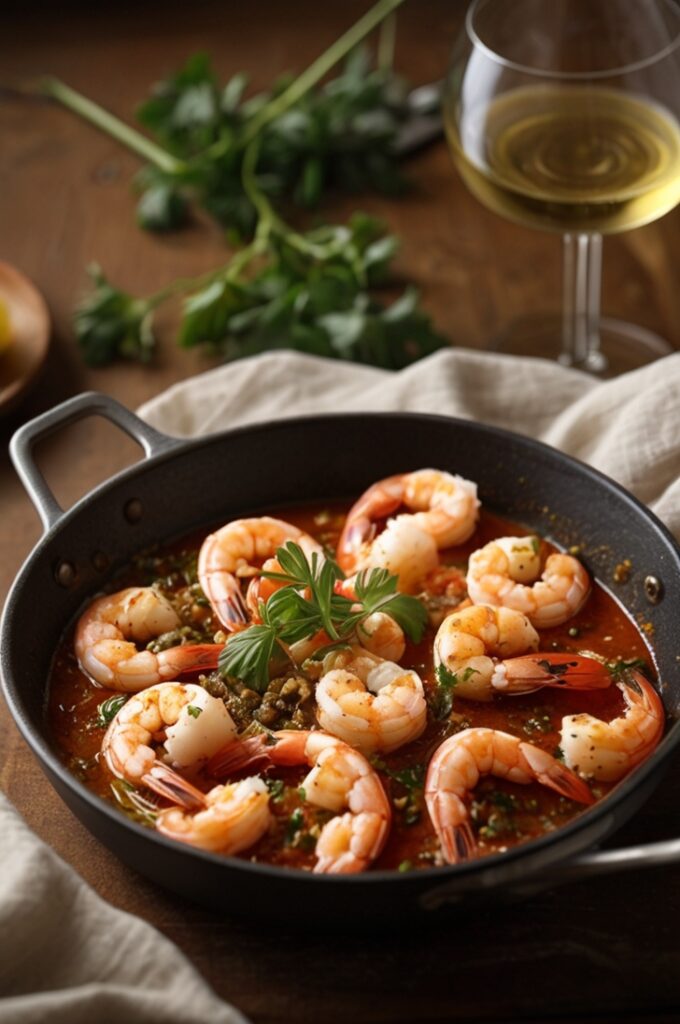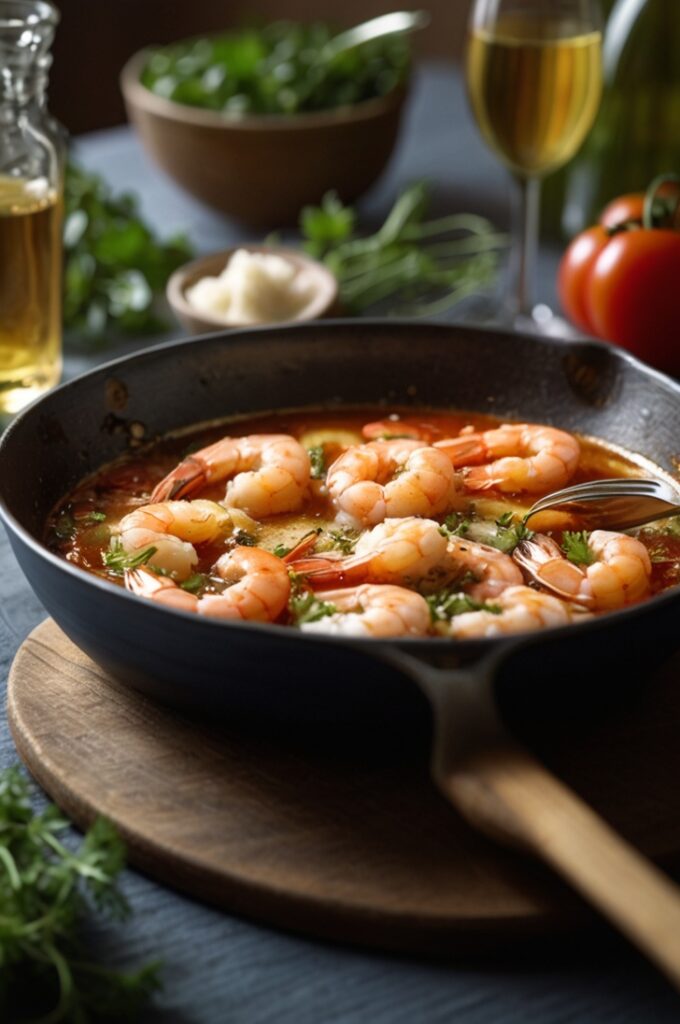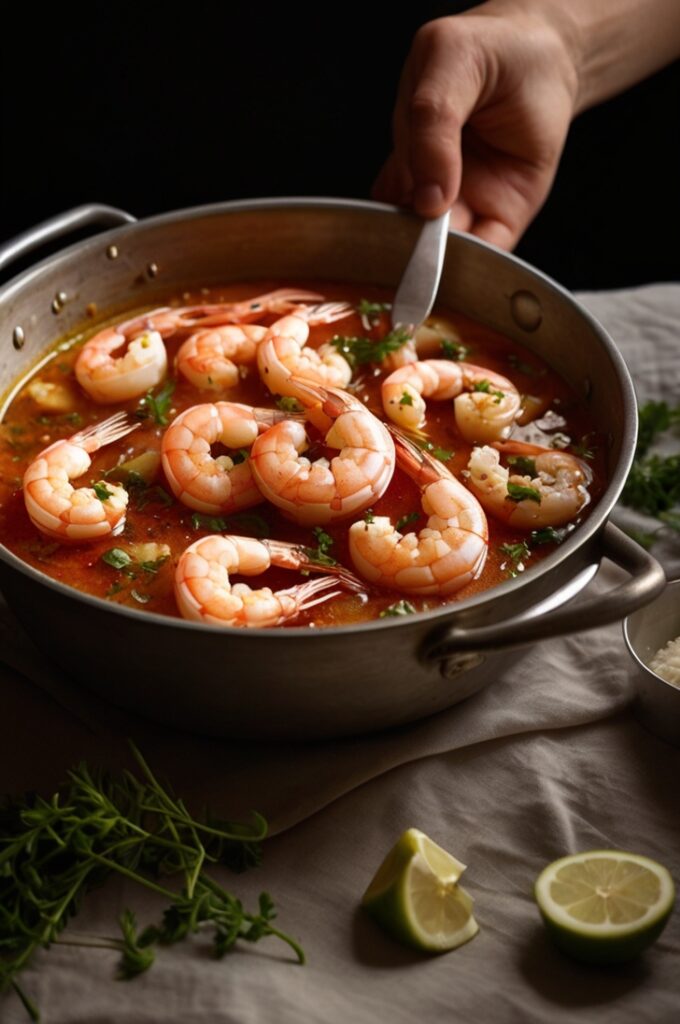Shrimp Saganaki A Greek Classic isn’t just something you whip up it’s something you remember. First time I tried it, it wasn’t in some fancy restaurant. Nope. It was in a sun-worn taverna on a craggy coastline in Naxos. Salt in the air. Retsina sweating in a chipped glass.
A clay dish bubbling its way to the table, fiery red sauce popping like it had something to say. And then that first bite shrimp barely cooked, sweet and briny, tangled in tomatoes and brash feta knocked me sideways. Yeah. It was that kinda moment.
Now, you’d think a dish with that much flair would be complicated, right? Spoiler: it’s not. Shrimp saganaki is pure Mediterranean alchemy. Fresh seafood, tomato, olive oil, garlic, and feta it’s peasant food, but the kind that tastes like a secret. And if you do it right, it sings. Loud. Like bouzouki in your mouth.
Let’s break this one down like the Greeks do with love, olive oil, and no time for shortcuts.
What Exactly Is Shrimp Saganaki?

Alright, let’s be clear. “Saganaki” isn’t the name of a dish it’s the name of the pan. A small two-handled frying pan, traditionally used for cheese, shrimp, or mussels cooked over high heat and served sizzling. So technically? This dish is shrimp cooked in a “saganaki” pan. But no one’s gatekeeping, promise.
It’s a mezze dish. A starter. But if you toss in some grilled bread or a bowl of rice, it becomes dinner real fast. The genius of shrimp saganaki lies in contrast. Sweetness of tomato. The tang of briny feta. The faint hit of ouzo if you’re brave. And those shrimp? They better not be overcooked, or so help me…
Ingredients & Substitutions
Let’s talk about what you need, and what you can fudge.
Main Ingredients:
- 1 lb (450g) raw shrimp, peeled & deveined (tails on = drama, your call)
- 2 tbsp olive oil (go extra virgin or go home)
- 3 garlic cloves, thinly sliced
- 1 small yellow onion, finely chopped
- 1 red chili or pinch of chili flakes (optional but I always vote yes)
- 1 cup canned crushed tomatoes (San Marzano if you’re feeling bougie)
- 1 tbsp tomato paste (deepens flavor, don’t skip)
- 1/4 cup dry white wine (or ouzo if you want that licorice kick)
- 1 tsp dried oregano (Greek, ideally yes, it matters)
- 1/4 tsp sugar (just a whisper to balance acidity)
- 3.5 oz (100g) feta, crumbled (not pre-crumbled stuff, please)
- Fresh parsley or dill for garnish
- Salt & cracked black pepper to taste
Optional upgrades or subs:
- Shrimp substitute: Try scallops or mussels if shrimp ain’t your vibe.
- Tomatoes: Fresh Roma tomatoes, peeled and grated, work if you hate cans.
- Feta: Use soft goat cheese if lactose is an issue, though it’s not quite the same.
- Ouzo: If that’s too wild, dry vermouth adds a mellow sweetness.
- Herbs: Dill leans floral, parsley is bright pick one. Or both.
One note: please and I mean this with all due respect don’t use pre-cooked shrimp. That’s how you kill the dish.
Step-by-Step Instructions

This dish comes together quick. Blink and you’ll miss it.
1. Sauté the aromatics.
Heat your pan (yes, you can use a cast iron or heavy skillet) over medium heat. Add olive oil, then the onion. Let it sweat, not brown. Garlic goes in next. If it smells like it’s dancing, you’re doing it right.
Expert tip: Don’t rush the onions. Translucent means mellow sweetness, not harsh bite.
2. Introduce the fire.
Add chili flakes if using. Stir in tomato paste and let it fry for a minute it’ll caramelize and deepen. Deglaze with wine (or ouzo) and let it bubble until it no longer smells like raw booze. We’re not making cocktails here.
Mistake to avoid: Pouring in tomatoes too soon. Let the wine reduce or your sauce’ll taste sharp.
3. Add tomatoes, oregano, sugar, and simmer.
Let the sauce cook down for about 10 minutes, uncovered. It should thicken a bit not soupy, not pastey. Somewhere in-between. Like a juicy stew.
4. Add shrimp. Gently.
Nestle those shrimp into the sauce. Cover them. They only need 2–3 minutes per side. The moment they curl into a “C” and turn opaque pull ’em. Don’t wait for “O” shape shrimp. That’s the overcooked death spiral.
Chef secret: Take it off the heat when shrimp are just underdone. Residual heat will finish them off. Trust the pan.
5. Finish with feta.
Sprinkle crumbled feta on top. Let it melt slightly it shouldn’t disappear into the sauce. You want soft nuggets of tang, not creamy sludge.
6. Garnish like you care.
A scattering of fresh parsley or dill lifts the whole dish. Fresh herbs aren’t optional. They’re life support.
Cooking Techniques & Science
You’re building a layered sauce in 20 minutes flat. That means every step has to count.
Why cook tomato paste first?
Raw paste is flat and metallic. Frying it caramelizes the sugars and unlocks deep umami. It goes from tinny to toasty.
Why not pre-cook shrimp?
Shrimp are delicate creatures. Overcooking turns them rubbery. Cooking them directly in the sauce ensures even, gentle heat and maximum flavor absorption.
Why feta last?
Feta doesn’t need to melt fully it’s salty, acidic, and crumbly. If you stir it into the sauce too early, it breaks and turns gritty.
Tools that help:
- Cast iron skillet or ceramic dish holds heat well.
- Fish spatula for gentle shrimp turning.
- Microplane if you’re grating garlic instead of slicing (some chefs do).
And please. No nonstick pans here. They don’t get hot enough and rob you of flavor development.
Serving & Pairing Suggestions
Shrimp saganaki ain’t shy. It’s rich, bold, and loud. You need calm around it.
To serve:
Scoop it into a shallow bowl. Don’t fuss too much this dish is rustic. Let the feta peek through. Sauce should pool, not drown. Toasted sourdough on the side, thick slices, brushed with olive oil. Maybe grilled lightly. Dip. Tear. Mop. Repeat.
Pair with:
- Drink: Dry rosé, crisp Assyrtiko, or retsina if you want to keep it old school.
- Side: Cucumber salad, lemon potatoes, or just a hunk of good bread.
- Main event: This can be the main. Add a side of rice or orzo tossed in lemon zest if you want to stretch it.
What Makes Shrimp Saganaki Special?

It’s one of those rare dishes where simple ingredients punch above their weight.
It’s flavor geometry. Sweet-tart tomato. Briny shrimp. Salty cheese. Herby lift. All in a tiny clay dish that screams, “feed me to someone you love.” And you should.
It also teaches restraint. Don’t over-stir. Don’t overcook. Don’t overthink. Good ingredients, good technique, done with heart.
FAQs About Shrimp Saganaki A Greek Classic
1. Can I use frozen shrimp for this recipe?
Yes, but thaw them fully and pat dry. Frozen shrimp tend to release water, which can dilute your sauce.
2. What kind of feta is best?
Use block feta in brine. Avoid pre-crumbled it’s coated in anti-caking agents and lacks depth.
3. Is ouzo necessary?
Nope. But it adds a whisper of anise that elevates the dish. If you’re not into licorice, skip or sub with dry vermouth.
4. How spicy is it?
You control the heat. One red chili = a gentle kick. Add more if you like it feisty. Or leave it out entirely.
5. Can this be made ahead?
Not really. The shrimp are best freshly cooked. But the sauce? That can be made ahead and reheated. Just add shrimp at the end.
Shrimp saganaki ain’t just dinner it’s a conversation-starter. A show-off without being showy. And if you do it right? You’ll swear you can hear the Aegean from your kitchen window.
Final Tips from the Line
- Use raw, not pre-cooked shrimp. Always.
- Finish with a drizzle of raw olive oil for that peppery kiss.
- Ouzo is optional but magic. Use sparingly, like perfume.
- Taste the sauce before you add shrimp. Adjust salt then not after.
This dish is forgiving but not forgettable. Once you make it right, it’ll make a home in your repertoire.




